Restore Your Hot Tub: Fix Green Water with Expert Tips
March 09th, 2024
March 09th, 2024
A hot tub should be a sanctuary, a place where you escape the chaos of daily life. However, when the water turns an uninviting shade of green, it can feel like your relaxation haven has been transformed into a swamp. This unfortunate turn of events might be all too familiar if you've ever neglected maintenance or skipped a crucial cleaning session. The sight of murky water isn't just unappealing; it's a sign of imbalance that can pose health risks if not promptly addressed.
Years ago, I faced this challenge after returning from a long vacation. The anticipation of soaking away travel fatigue was quickly replaced by dismay at the green water waiting to greet me. Determined to reclaim my oasis, I embarked on a mission to restore the clarity and health of the water, learning valuable lessons along the way. This experience taught me the importance of understanding what causes such discoloration—often a result of algae growth, improper chemical balance, or inadequate filtration.
Through trial and error, I discovered effective methods to tackle the issue swiftly. By closely monitoring chlorine levels, employing shock treatments, and ensuring the filtration system was free from blockages, I managed to restore the sparkling clarity of my hot tub. In the following sections, I’ll share these tried-and-true strategies, complete with a detailed video guide, to help you transform your own emerald waters back to a welcoming blue.
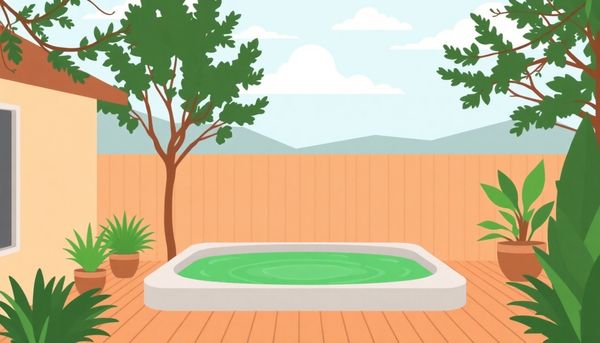
Once upon a time, you might have stepped into your backyard with dreams of a relaxing soak, only to find your hot tub resembling a swampy lagoon. That's not exactly the spa day anyone envisions. Algae, the green menace, thrives in the unlikeliest of places, particularly when your hot tub's chemical balance takes a backseat. It's like an uninvited guest at the party, but thankfully, you can show it the door swiftly.
Begin by rolling up your sleeves and grabbing a test strip or a liquid test kit. Assess the pH and alkalinity of your water; these are your first lines of defense. A balanced pH, ideally between 7.4 and 7.6, and alkalinity within 100-150 ppm are crucial. If your readings are amiss, it's time to adjust. For low levels, an Alkalinity Increaser or some trusty baking soda might do the trick. Conversely, a pH Decreaser can help if levels are high, ensuring your tub doesn’t become an algae haven.
Next, it's shock therapy for your spa. A hefty dose of chlorine shock will wage war against the algae. Even bromine users should reach for chlorine in this scenario. Double or triple the normal quantity if the algae appear particularly stubborn. While the chlorine does its work, keep the cover off to allow the chemicals to dissipate into the air, preventing any lingering residues.
By tackling algae growth promptly and decisively, you prevent it from gaining a foothold. So next time your hot tub hints at turning green, you'll be ready to reclaim your peaceful retreat.
Discovering the origin of green-tinted water in your hot tub can feel like solving a mystery. The vibrant hue often points to algae or the presence of metals, particularly copper. Each source requires a unique approach to regain that inviting clarity.
Algae, the prime suspect, thrives in warm, poorly sanitized environments. It can sneak into your spa through various conduits: a swimsuit that wasn’t thoroughly rinsed after a dip in a lake, or even from the natural elements if your tub is outdoors. Without diligent maintenance of chlorine or bromine levels, algae multiply, transforming your relaxing oasis into a slimy green swamp. Your first clue: slimy walls and water with a suspiciously verdant tint.
Metals tell a different tale. Copper, often lurking in your water supply, can turn your hot tub into a green haven when it reacts with sanitizers like chlorine. This is a silent offender; unlike algae, copper doesn't make the water slimy. Instead, its subtle intrusion is detected when your water appears clear yet green. A hose filter can be your ally here, preventing copper from entering your tub in the first place.
Regular testing of water parameters can pinpoint whether the villain is algae or metal. Armed with this knowledge, you can tailor your intervention and bring back the sparkling waters that beckon relaxation.
When faced with the mysterious green tint in your hot tub, it's crucial to tackle the underlying chemistry that may be causing the issue. The delicate dance of pH, alkalinity, and sanitizer levels is at the heart of maintaining crystal-clear water. Begin with the basics: grab a test strip or a liquid kit to examine the pH and total alkalinity levels. Although strips are quick and convenient, a liquid test might offer more precision if you're a stickler for accuracy. Aim for a pH of 7.4 to 7.6 and total alkalinity between 100-150 ppm to keep your water happy.
Adjustments might be necessary if your readings stray from these targets. I've found that baking soda works wonders to boost alkalinity, while a dedicated pH decreaser can bring overly high levels back down. After achieving balance, it's time for a chlorine shock treatment. Even if you typically use bromine, a dose of chlorine shock is essential for obliterating stubborn algae. This isn't the moment for timid measures; double or even triple your usual shock amount if algae seem particularly resilient.
During this process, make sure the hot tub cover is off and jets are on low. Scrub any visible algae with a nylon brush to enhance chlorine's effectiveness. With patience and a bit of chemistry know-how, your hot tub will soon be free of its green hue, ready to offer clear and inviting waters once more.
Is there a quicker way to reclaim crystal-clear waters in your hot tub after a rogue algae invasion? Indeed, the answer lies in the power of a good shock treatment. Picture your hot tub as a miniature ecosystem; when algae take root, it disrupts this delicate balance. To restore order, a chlorine shock acts as a powerful reset, obliterating algae and clearing the murky green tint.
Begin by checking and adjusting your hot tub’s pH and alkalinity levels. The right balance, ideally a pH between 7.4 and 7.6 and alkalinity from 100-150 ppm, is crucial, as it ensures the shock treatment works most effectively. Unbalanced water can hamper chlorine's effectiveness, leaving those pesky algae untouched.
Once your water is balanced, it's time to administer the shock treatment. Choose a chlorine-based shock for this task. Even for bromine users, a chlorine shock is essential to eradicate algae efficiently. Don’t skimp on the dosage; for severe infestations, double or even triple the usual amount can be necessary. With the cover removed and jets on low, allow the shock to work its magic over 24 hours, keeping the cover off to let any trapped gases escape.
In this battle against algae, every detail counts. Remove your hot tub filters temporarily to prevent them from impeding the chlorine’s reach. Scrub the walls with a nylon brush to dislodge stubborn algae, allowing the chlorine to act directly on the contaminants. By following these steps, you’ll soon bid farewell to green water, welcoming back the pristine clarity that makes your hot tub the relaxing oasis it should be.

Balancing pH and alkalinity in your hot tub might sound like a chemistry class, but it's a crucial step in banishing that unwelcome green hue. One evening, after a long day at work, I slipped into my hot tub only to be greeted by murky, green water. Not the relaxing experience I had hoped for! I quickly learned that the clarity of spa water often hinges on its chemical balance.
Begin by grabbing a reliable test strip or a liquid test kit to measure your hot tub's pH and total alkalinity. Aim for a pH level between 7.4 and 7.6, and ensure total alkalinity sits between 100-150 ppm. If numbers are off, don't panic; adjusting them is straightforward. For low alkalinity, a sprinkle of baking soda works wonders, while high levels can be tamed with a pH decreaser.
Once your pH and alkalinity are in check, it’s time to address algae directly. A vigorous dose of chlorine shock will often do the trick. Even if bromine is your sanitizer of choice, chlorine provides the punch needed here. Just remember to scrub away any clinging algae manually to give the shock its best chance.
In my case, once I balanced those levels, the water cleared up in no time, and my hot tub was back to being the serene retreat I needed. Balancing chemicals may not be glamorous, but it’s the secret to keeping your spa invitingly crystal clear.
Green water in hot tubs might seem like a rare hiccup, yet those battling its emerald hues know it's a formidable foe. Algae and copper, the usual suspects, work their mischief in warm, untreated water, turning your serene soak into a swampy surprise. While draining and refilling may offer a quick fix, it's not always a feasible approach. So, let's explore a more practical solution to this verdant puzzle.
Start by testing the water to see if the pH and alkalinity levels are within the ideal range. Test strips are handy, offering a quick snapshot of your water’s health. When levels are off-kilter, take corrective steps with pH increasers or decreasers. Balanced water is less inviting to algae, keeping that slimy green from taking hold. Your pH should ideally hover between 7.4 and 7.6, with alkalinity nestled between 100-150 ppm.
Once the water is balanced, it's time to bring out the big guns: a chlorine shock treatment. This concentrated dose of chlorine attacks algae at its roots. Tackle stubborn patches with a nylon brush, ensuring no algae can hide. Allow the chlorine to work its magic for at least 24 hours, keeping the cover off to let excess gases escape. This method not only resolves the immediate issue but sets the stage for a sparkling, trouble-free soak in the days to come. Remember, maintaining a clean, well-balanced hot tub is key to preventing these aquatic invaders from reappearing.
Copper-induced discoloration can turn your inviting hot tub into a murky mystery. When copper mingles with chlorine or bromine, it transforms the water into an unwelcome shade of green, reminiscent of an algae invasion but with a clearer appearance. Identifying this culprit is crucial to tackling the issue without the need for a complete water change.
The copper often sneaks in through the tap water used to fill your tub, particularly from older pipes or well water. To combat this, a simple yet effective tool is a hose filter. It acts like a secret agent, capturing copper before it enters your oasis. If you suspect copper is already present, a metal sequestrant can be your best ally. This product binds with the copper ions, preventing them from reacting with chlorine and causing the green hue.
In my own backyard escapades, I discovered the power of weekly monitoring. Regular testing for metal content in the water can save you from unexpected surprises. By maintaining balanced metal levels, you not only keep your hot tub crystal clear but also protect its plumbing and surfaces from potential damage. So, while copper may lend a hand in creating iconic landmarks like the Statue of Liberty, it’s best kept out of your hot tub’s chemistry. Keeping metal levels in check ensures your tub remains a source of relaxation, not frustration.
Balancing the chemistry in your hot tub can feel like solving a puzzle. Each piece, from pH to alkalinity, plays a crucial role in preventing green water. Think of pH and alkalinity as the unsung heroes of water maintenance. They work behind the scenes, ensuring your tub stays pristine and inviting. When these levels stray from their ideal range, it's like opening a door for algae and other unwelcome guests.
Testing your hot tub water is step one. Armed with a simple test strip or a liquid test kit, you'll get a snapshot of your water's current state. Ideally, your pH should hover between 7.4 and 7.6, while total alkalinity should settle within 100-150 ppm. These numbers aren't just random; they form the foundation of a stable spa environment.
Once you've identified any imbalances, the real action begins. Low pH and alkalinity can be remedied with an alkalinity increaser or household baking soda, which gently nudges these levels upwards. On the flip side, if your readings are too high, a pH decreaser will bring them back in line. Remember, balanced water isn't just about aesthetics—it's about safeguarding your tub and ensuring a comfortable soak every time.
After achieving the right chemical balance, it's time to tackle any lingering algae or contaminants with a chlorine shock treatment. This powerful step clears the way for crystal-clear water, allowing you to enjoy your hot tub without a hint of green.
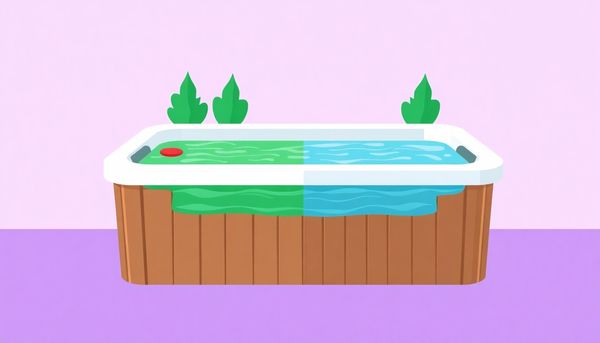
Metal contaminants, particularly copper, are often sneaky culprits behind that unsettling green hue in your hot tub. This happens when copper, present in your water supply, reacts with chlorine or bromine. The transformation isn’t unlike the one that turned the Statue of Liberty green over time. Cities or well water can introduce copper into your spa, especially when using an unfiltered garden hose. I learned this the hard way when I first filled my tub, only to be greeted by an emerald surprise a few days later.
To tackle this metallic menace, begin by investing in a hose filter. This simple device ensures that copper and other metals are caught before they ever reach your hot tub. If you suspect that metals have already invaded, a metal sequestrant can be your best ally. These products bind with metal ions, preventing them from reacting with sanitizers. Just pour the recommended amount into your water, and let it work its magic.
Additionally, it’s crucial to regularly test your water for metal levels. I keep a bottle of test strips handy for this exact reason. They’re simple to use and provide peace of mind that everything is in balance. By staying vigilant and addressing metal contaminants promptly, you can restore your hot tub to its inviting, clear state without having to drain and refill.
Hot tub water doesn’t just decide to turn green on a whim; something is definitely amiss. Two of the most common culprits behind this unsettling change are algae and copper. Algae, those tiny green intruders, thrive in warm and poorly sanitized water. If your chlorine or bromine levels are not up to par, it’s like rolling out the welcome mat for these unwelcome guests. I recall a friend who left his hot tub unattended for a week during a heatwave, only to find it transformed into a mini swamp, all thanks to the flourishing algae.
On the flip side, if the water is clear yet green, copper might be your antagonist. Copper can sneak into your hot tub via the water source itself, especially if it’s coming from older plumbing systems or well water. It’s reminiscent of the way the Statue of Liberty gradually turned green due to the reaction between copper and the elements. This same reaction can occur in your hot tub when copper meets chlorine or bromine, resulting in that infamous green tint. Using a hose filter when filling your hot tub can help prevent this colorful scenario.
Understanding whether your hot tub’s greenness stems from algae or copper is crucial. If your tub feels slimy, algae is likely to blame. But if it’s not, and the water looks clear, copper is the likely suspect. Identifying the cause sets the stage for restoring your hot tub to its former glory.
When tackling the mysterious green water in your hot tub, balancing water chemistry is akin to orchestrating a symphony. Each element plays a crucial role, and any discord can lead to unwanted results. Your first move is to test the waters, so to speak. A simple test strip or a more precise liquid test kit will reveal which components need adjustment. Personally, I've found test strips to be a handy tool—their speed and simplicity make them a favorite, especially when time is of the essence.
Aiming for perfection, your pH should nestle between 7.4 and 7.6, while total alkalinity should sit comfortably at 100-150 ppm. If these parameters stray, it’s time for some fine-tuning. To elevate both alkalinity and pH, an Alkalinity Increaser is your ally. On the flip side, should they peak too high, a pH Decreaser becomes your go-to.
Once the orchestra is in tune, bring in the big guns: a chlorine shock treatment. Even if you usually rely on bromine, doubling or even tripling the chlorine shock can be the decisive strike against stubborn algae. Don’t forget to whip out the nylon brush and get scrubbing—this manual intervention helps the chlorine do its job effectively.
Remember, the success lies in the details. Removing the filters temporarily and ensuring your hot tub cover is off can significantly enhance the treatment’s efficacy. With patience and precision, your hot tub will gleam once again, ready for a soothing soak.
In the quest to clear up that stubborn green hue in your hot tub, copper filters play an unexpected yet crucial role. Imagine filling your tub with what seems like pristine water, only to discover it has a sneaky source of copper. This metal, often introduced through city or well water, can transform your relaxing oasis into a greenish nightmare when it reacts with chlorine or bromine. Copper filters are your secret weapon in this battle, preventing the issue before it even starts.
Whenever I fill up my hot tub, I reach for a high-quality hose filter, a habit I've adopted after learning the hard way. This simple tool attaches to your garden hose and effectively removes metals and particulates. The result? A noticeable difference in water clarity and color from the get-go. Having experienced that clear-water bliss, I can confidently say it's a worthy investment for any hot tub owner.
Moreover, while the filter does its magic when filling or refilling, it’s important to regularly check your water’s metal content. Use a metal sequestrant if levels spike unexpectedly. This additional step ensures that copper doesn’t accumulate over time, maintaining the sparkling blue of your spa. Embracing the use of copper filters not only saves you from the headache of algae-like discoloration but also extends the lifespan of your beloved hot tub.
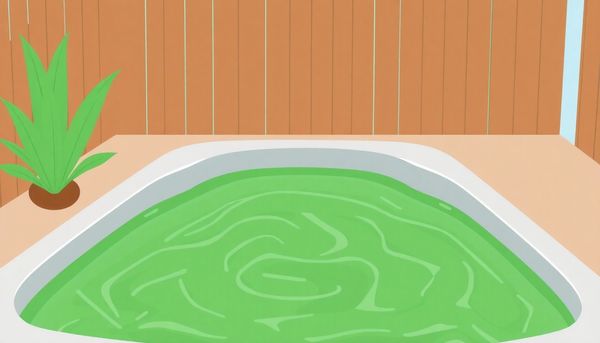
Transforming green, murky water back into the clear oasis you remember isn't just a matter of luck. It requires a strategic approach, and shocking your hot tub is often the hero of this story. Start by gathering your tools – a reliable chlorine shock solution, test strips, and a nylon brush. These are your trusty companions in defeating the algae lurking in your tub.
First on your to-do list is testing the water. Dip the strip and let it tell the tale of your hot tub's pH and alkalinity. You want pH to sit between 7.4 and 7.6 and alkalinity to hug the range of 100 to 150 ppm. Adjustments are necessary if the numbers don't align. Think of it as prepping the battlefield for the chlorine shock to do its magic.
With the pH and alkalinity in check, it’s time to kick things up a notch. Remove the hot tub cover and activate the jets on a low setting while ensuring air valves are off. This setup will circulate the shock throughout the water. Now, for the main act: generously apply your chlorine shock. If algae is noticeably persistent, don't hold back—double or triple the usual dose. Scrub any visible algae with the nylon brush to ensure the shock penetrates even the most stubborn areas.
Once the shock is in, patience becomes your ally. Leave the cover off and allow the chlorine to work for a full 24 hours. This waiting period not only clears the algae but also helps any residual chlorine gas off. By the end of this process, your hot tub will be well on its way to regaining the clear, inviting water you miss.
Identifying the root cause of green water in your hot tub can feel a bit like playing detective. On one hand, algae may be the culprit, eager to transform your relaxation haven into a slimy nightmare. Warm, unsanitized environments serve as perfect breeding grounds for these tiny invaders. You might notice a slippery feel on the walls of your tub, signaling their unwelcome presence. A personal tip: I always keep an eye on the water's clarity and touch the tub's surface regularly to catch any algae growth early.
On the other hand, if your water feels clear but still carries a green hue, metals like copper could be to blame. This discoloration results from a chemical reaction between copper and sanitizers like chlorine or bromine, much like the iconic green patina of the Statue of Liberty. Copper can sneak into your hot tub from your source water, especially if you fill it using an unfiltered garden hose.
To differentiate, consider the water's feel and appearance. Slimy walls often point to algae, while clear, green water hints at metal issues. Tackling algae requires balancing water chemistry and using chlorine shock. Meanwhile, addressing metal content often involves using a metal sequestrant or filter to remove these impurities. Understanding these distinctions ensures your hot tub remains a place of comfort, not confusion.
In any hot tub saga where the water turns an unexpected shade of green, the hero often emerges as balanced water chemistry. Ensuring your hot tub’s pH and alkalinity are in harmony creates a hostile environment for algae and prevents metal reactions that could tint your oasis green. Think of it as setting the stage for a thriving aquatic performance.
When I first encountered green water in my own hot tub, I quickly learned that keeping pH levels between 7.4 and 7.6 and alkalinity from 100 to 150 ppm was crucial. Testing these regularly with a simple test strip is as easy as pie, but for those who crave precision, a liquid test kit is the way to go. It’s like checking the vital signs of your hot tub and can save you from future headaches.
Adjustments may be necessary if your measurements fall short or overshoot these numbers. Alkalinity increasers, such as baking soda, can be your best friends to elevate those figures. Conversely, if they run high, a pH decreaser steps in like a superhero, saving your skin and eyes from irritation and your equipment from damage. Once these levels are balanced, a well-timed chlorine shock can obliterate any remaining algae invaders and restore clarity to your hot tub. By mastering this balance, you not only rescue your spa from the green menace but also ensure it remains a haven of relaxation and pleasure.
A sudden splash of green in your hot tub can be alarming, but a chlorine shock treatment can quickly return your spa to its pristine state. Recognizing algae as the culprit requires immediate intervention. Begin by ensuring that your pH and alkalinity levels are within the ideal ranges; pH should sit comfortably between 7.4 and 7.6, and alkalinity should be between 100-150 ppm. Accurate testing provides the foundation for effective shock treatment, making those test strips or liquid kits your best friends in this process.
Once your water chemistry is balanced, it's time for the chlorine shock treatment to take center stage. Even if your hot tub uses bromine, a hefty dose of chlorine is essential to eradicate algae. For stubborn green invaders, don’t hesitate to double or triple the recommended amount of chlorine shock. This ensures any lurking algae have no chance to survive. A chlorine-based shock, packed with an oxidizer, will not only target algae but also eliminate any residual bacteria and contaminants.
Remove the hot tub cover to let chlorine gas dissipate, and engage your jets on a low setting while keeping air valves shut for optimal circulation. Use a nylon brush to dislodge any algae clinging to the walls—a small but crucial step in aiding the chlorine's mission. Leave the cover off for at least 24 hours, allowing the chlorine to thoroughly cleanse the water. Your patience is rewarded with clear, inviting water, ready to welcome you back into its soothing embrace.
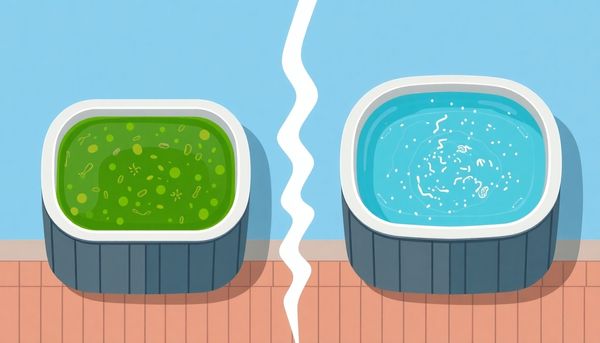
Unearthing the secrets of crystal-clear hot tub water isn't a journey you must take alone. A video guide can illuminate each step, transforming confusion into clarity with practical demonstrations. Imagine standing beside a seasoned expert who guides you through each action, from testing your water's pH balance to applying shock treatment effectively. Videos offer this virtual mentorship, breaking down complex processes into manageable parts.
When I first encountered green water in my own hot tub, reading instructions felt like deciphering a complicated map with missing landmarks. That's when I turned to video guides. Watching someone test water using strips, seeing the exact amount of shock added, and observing the removal of filters provided a much-needed visual reference. Each click of the play button brought confidence, knowing I wasn’t just fumbling through with guesswork.
These videos often include handy tips not found in text alone. For instance, I learned the importance of removing the hot tub cover to prevent chlorine gas buildup—something I might have overlooked otherwise. The beauty of video content is its ability to show real-time results, adjusting techniques based on immediate feedback. This dynamic learning tool ensures you're not just reading about processes; you're witnessing them, which can make all the difference between success and frustration in your hot tub maintenance adventures.
There's something oddly disconcerting about lifting the lid of your hot tub to find a greenish tint in the water. The likely culprits? Algae and metals. Algae, those pesky microscopic plants, thrive in warm, unsanitized water. If you’ve ever noticed a slimy coating on the walls of your tub, you’re dealing with an algae invasion. To tackle this, start by checking and balancing your water’s pH and alkalinity. Proper levels create an environment where algae find it hard to survive. Once balanced, a robust chlorine shock treatment is your best friend. This not only attacks and kills the algae but also clears up your water, making it inviting once more.
But what if the walls aren’t slimy, and the water remains translucent yet green? Chances are, you’re looking at a metal issue, specifically copper. This metal might hitch a ride into your hot tub via your household water source. Copper, when combined with chlorine or bromine, can cause that unsightly green hue reminiscent of the Statue of Liberty’s patina. Employing a hose filter when filling your tub can prevent this. For existing metal woes, using a metal sequestrant can bind these metals and help remove them. Balancing your water chemistry ensures that metals don’t get a chance to react with sanitizers, keeping your tub clear and inviting.
Tackling the mystery of green hot tub water might seem daunting at first, but our step-by-step video guide simplifies the process into manageable tasks. Think of it like having a friend walk you through each move, ensuring you don’t miss a beat. We break down everything from diagnosing the cause—whether it’s pesky algae or a mischievous copper reaction—to executing the perfect chemical balance.
Ever had that moment where you wished you could hit pause and replay instructions? Our video allows you to do just that, offering visual cues and practical tips that transform a potentially frustrating task into an enlightening experience. You’ll learn how to test water chemistry, adjust pH levels, and apply the right amount of chlorine shock—all without draining your entire hot tub.
Imagine the satisfaction of seeing crystal-clear water once more, ready for a late-night soak or an early morning relaxation session. The video also includes insider tips on using tools like a nylon brush to tackle stubborn algae and the importance of aeration to boost chlorine efficiency. Solving green water issues not only saves time and money but extends the life of your hot tub. So grab your test kit, some shock treatment, and press play to reclaim your water’s pristine clarity.
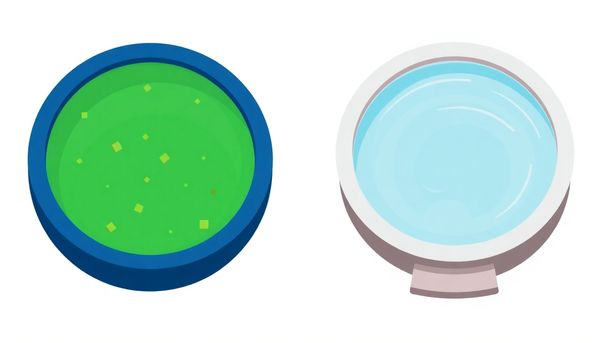
This article provided insights into maintaining your pool. Start your pool care journey today!
Want to become a pool maintenance expert? Our free Pool School course covers everything you need to know about pool care. From basic maintenance to advanced troubleshooting, you'll learn how to:
Join over 10,000 pool owners who have already transformed their pool care routine. Get started with our free Pool School course today!